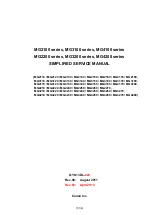
e-STUDIO2555C/3055C/3555C/4555C/5055C
© 2012-2013 TOSHIBA TEC CORPORATION All rights reserved
OUTLINE OF THE MACHINE
3 - 22
3.4
Copy Process
Fig. 3-13
(1)
Charging: Places a negative charge on the
surface of the photoconductive drum.
(6)
1st transfer: Transfers the visible image
(toner) on photoconductive drum to the
transfer belt.
↓
↓
(2)
Original exposure: Converts images on the
original into optical signals.
(7)
2nd transfer: Transfers the visible image
(toner) on the transfer belt to paper.
↓
↓
(3)
Data reading: The optical image signals
are read into CCD and converted into
electrical signals.
(8)
Fusing: Fuses the toner image to the paper
by applying heat and pressure.
↓
↓
(4)
Data writing: The electrical image signals
are changed to light signals (by LED
emission) which expose the surface of the
photoconductive drum.
(9)
Blade cleaning: While scraping off the
residual toner from the drum by the blade.
↓
↓
(5)
Development: Negatively-charged toner is
made to adhere to the photoconductive
drum, producing a visible image.
(10)
(–) Discharging: Eliminates the residual (–)
charge from the surface of the
photoconductive drum.
↓
CCD
Carrier
Toner
(-) Discharging (LED array)
Cleaning
Paper exit
1st transfer
2nd transfer
Photocon-
ductive drum
Data reading (scanning)
Original exposure
LED lamp
Image processing
Data writing
LED head
Magnetic roller bias
Black development
Charger (grid voltage)
Fusing
IH coil
Bypass feeding
Drawer feeding
PFP/LCF feeding
8
7
2
3
4
1
10
6
5
9
Summary of Contents for e-studio 2555c
Page 6: ......
Page 10: ......
Page 1550: ......
Page 1557: ......
Page 1558: ...1 11 1 OSAKI SHINAGAWA KU TOKYO 141 8562 JAPAN ...
















































